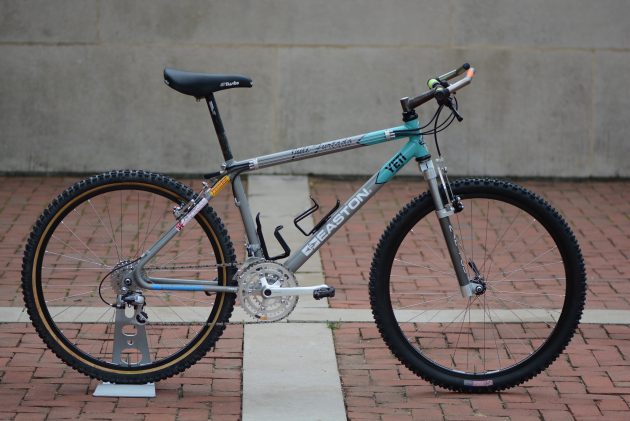Be Kind, Rewind: Yeti Arc prototype
Originally posted on October 3, 2018 at 0:01 amEditor’s note: This story originally ran in issue 206 of Dirt Rag Magazine. Like what you see? Issue 207 is out now on newsstands. Click here to subscribe today to ensure you never miss a story.
 By Martin
By Martin
I love a good barn find. I mean, who doesn’t love a story about an old relic forgotten and ravaged by time, then rediscovered and brought back to life? Imagine my excitement when a chance encounter brought me the opportunity to acquire and restore one of the most iconic mountain bikes of my generation.
Juli Furtado famously burst onto the mountain bike scene in 1990, coming out of virtually nowhere to win the inaugural UCI World Championships aboard a prototype carbon/steel composite Yeti C-26 provided by John Parker of Yeti Cycles. There is more to the story, but that’s for another time.
Carbon bicycle technology was still in its infancy, and despite immense pressure from Easton (who made the C9 tubing for the C-26), Parker wasn’t comfortable building the carbon bike. He began searching for a new material to build lighter race frames. In 1988 Parker worked on the America’s Cup catamaran, which employed an aluminum alloy that was able to work harden and didn’t require heat treating. After moving Yeti Cycles to Durango, Colorado, Parker knew he wouldn’t have the means to heat treat the 6061-T6 aluminum commonly used by other manufacturers and wanted a material similar to what he used on the AC boat. Chuck Teixeira of Easton informed Parker that he was developing a 7000-series variably butted alloy that would not require heat treating and delivered some early 7005 tubing to Yeti (and Doug Bradbury of Manitou) in the fall of 1990 for development.
Parker was supremely proud of his Yeti brand. Yetis had steep angles, ovalized top tubes and one-piece “loopstay” rear triangles, making them immediately recognizable regardless of paint or componentry. He hated the original aluminum prototypes because they didn’t have loopstays and thus didn’t look like Yetis. So, Chris Herting, Frank the Welder, Teixeira and Bradbury continued development until two prototypes met Parker’s satisfaction. One was given to Furtado to race the 1991 World Cup circuit, and the other to Herting for testing and further model development. Herting’s proto was eventually cut apart for research. Furtado’s was stamped “World Champ” to commemorate her win a few months earlier.
Further development produced a result that would better resemble the production frame that Yeti dubbed Alloy Racing Composite, or ARC. Furtado retired the prototype in May and raced the remainder of the year on what would eventually be a stock ARC frame.
Parker’s time at Yeti ended shortly after Schwinn purchased the company in 1995. On his way out, he grabbed some memorabilia, including Furtado’s prototype aluminum Yeti, leaving it with Bradbury, who hung it in his attic for nearly 20 years. I met Bradbury in 2016 and ended up buying some of his leftover Manitou bikes, and among the lot I saw a dusty, half-built, beautifully crude Yeti. I spoke with Bradbury and Parker and they agreed to let me have it to restore.
What started next was a two-year quest to rebuild the bike back to how Furtado raced it at the start of the 1991 season.
Little touches really make this a special bike. Earlier steel Yeti frames had one-piece computer-bent chromoly rear triangles, a design borrowed from BMX frames like Mongooses. Yeti managed a similar rear end made of Easton 6061 for this bike, but it took incredible effort to bend the brittle metal into shape, and they knew the one-piece rear end was not producible in 7005. Thus, this is the only remaining aluminum Yeti to feature this unique and sexy rear triangle. The production ARC frame had two-piece rear ends joined at the seat tube and bottom bracket.
The top tube was round instead of the characteristic oval profile, which Easton had not yet developed in the 7005 alloy. The next-generation bike ditched these two features and more closely resembled the eventual production version of the ARC.
Machined Shimano XT brake and shifter mounts show the extent to which the team tried to shave weight. At 26.8 pounds, it’s no featherweight, but given the early Manitou front suspension and basic (but functional) Shimano parts, it’s pretty impressive and trimmed nearly 2 pounds off the steel Yeti FRO race bikes.
To me, this bike represents so much of what was great about mountain biking in the early ’90s: innovative spirit and cross-company collaboration constantly pushing the boundaries of what was possible. The sponsor decals and classic Yeti livery all communicate an aggressive approach to bike racing, the likes of which had not been seen before and which set the stage for years to come.
Footnote:
in memoriam
For years Jeff Archer wrote our Specialty Files column the previously occupied this space. On July 21, 2016, he was killed by a drunk driver while crossing the street. Archer was both a gentleman and scholar of bicycle history and will always be missed.